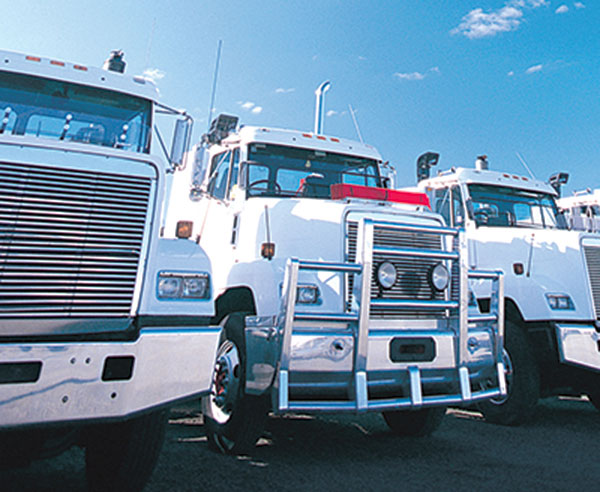Used equipment auctions provide an ideal place for sellers to list their items and for buyers to purchase equipment that fits their needs. From excavators and cranes to dozers and trucks, used equipment auctions offer a wide selection of items at an arguably better value than new equipment.
However, no buyer wants to end up with a lemon that requires additional investment to make it work properly. Managers in the market for a used truck can follow these simple tips to ensure they aren’t left with lighter pockets and a faulty machine:
- Mechanical – Crank the engine, and look for leaks, blow-by, smoke, etc. Move the truck forward and reverse in all gears to check the steering and brakes. This will also help identify any unusual noises.
- Structural – Structural issues can be expensive to fix. The main frame should be free of excessive wear. There should also be no loose or missing hardware, patches or modifications.
- Cosmetic – The cab interior should be clean with seats in good condition. Glass should be free of cracks. Ideally, paint should not be faded or chipped, and sheet metal or fiberglass should not be damaged or missing.
-
Options – Consider the way the equipment will be used, and look for features accordingly. If the truck will be used by multiple drivers, for instance, it may be best to purchase a truck with an automatic transmission because it is harder to find qualified people to drive manual transmission vehicles. Buyers should also consider whether their drivers have commercial driver’s licenses. Trucks above certain weights require operators to have such a license, and the regulatory requirements for these vehicles may be beyond the scope of some business plans (mandatory drug testing, etc.).

Buyers should note whether the truck is sold as is or if there are trade terms and warranties available. With trade terms, the buyer is assured that the truck has not been in a major accident, that there are no major leaks and that the brakes and tires are in good condition. Used trucks with trade terms may be more of an investment, but the buyer benefits by knowing that the item meets certain standards.
If there are any issues with the above categories, note them in the truck’s inspection report. Buyers should have access to these reports before they bid so that they can make informed decisions.
Additional Considerations
In recent years, trucks have been forced to comply with diesel regulations from the Environmental Protection Agency. Thus, it’s important for buyers to understand that if they are purchasing a used truck manufactured after 2007, they will have to perform periodic emissions system maintenance to maintain compliance. Manufacturer websites can help buyers understand more about the EPA’s regulation and maintenance requirements.
Buyers should also be aware of the mileage of the truck. Class 8 trucks that are being used frequently on the highway for hours at a time can operate for as many as 500,000 to 700,000 miles before being replaced. However, a vocational truck used throughout town that makes frequent stops will not be able to withstand half a million miles. An engine control module reading can more accurately identify the number of miles on a truck compared to an odometer. These readings are not always available when buying used trucks, so buyers will need to consider the age of the truck and whether it appears to be well maintained.
Trucks are often outfitted with accessories and attachments such as chrome fenders and paint designs. Since these additions increase purchase prices, buyers should be open to looking at trucks that don’t have many of these cosmetic extras. Some used trucks are sold with attachments that a buyer may not need, and simply buying a truck that can be mounted with the desired attachments can save money. Buyers also need to make sure the truck is capable of carrying the necessary attachments if it is bought on its own. There may be weight and frame-length limitations that affect your ability to place certain attachments on the truck.
Making the Purchase
To determine the average selling price of a truck with the desired specs, research prices online based on the information available at used truck websites and auctions. Brand loyalty can be a downfall. Often, multiple manufacturers offer trucks that can meet the buyer’s specifications, so buyer flexibility can lead to a better deal.
With online auctions, buyers do not have to spend time and money to travel, and they can use those savings to increase their purchasing ability during bidding. Online auctions also offer a selection of used trucks from around the world, giving buyers more opportunity to find the truck that is right for them.
Buyers should bid with an online marketplace that provides guaranteed inspection reports detailing everything about the equipment. Inspection reports should be so thorough that the buyer feels confident in the purchase without being onsite to look at the truck.
A Smart Buy
When purchasing a used truck, buyers must do their research to determine what truck is the best fit for them. Specs will be a driving force since each buyer has different needs. It’s essential to understand the mechanical, structural and cosmetic aspects of the truck and to assess features, tires, emissions systems, mileage and the ability to accommodate attachments. Buyers of used trucks can also avoid purchasing a lemon by bidding with an auction site that provides guaranteed inspection reports. With these guidelines in mind, you are sure to find the truck that best fits your needs.
